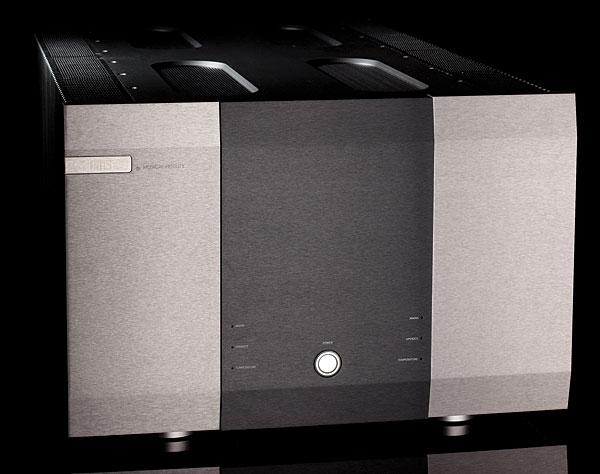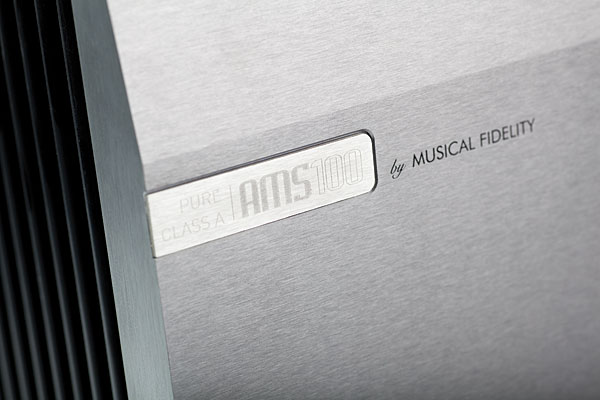| Columns Retired Columns & Blogs |
Holy smokes! that is a beautiful beast. I'll take it!

I was talking last winter to Musical Fidelity's Antony Michaelson, who had been enthusing about his forthcoming stereo amplifier, the AMS100. It would be physically enormous—almost a yard deep—and commensurately heavy at 220 lbs. Despite its bulk, its maximum rated output would be just 100Wpc into 8 ohms. It would also be expensive, at $19,999. And to cock a snoot at environmentalists and their concerns, the AMS100's output stage would be biased into class-A up to its rated 8 ohm power, meaning that, even when not playing music, it will draw around 10 amps from a typical US wall supply of 120V. This also means that it will run very hot, making the amplifier impracticable for summer use in homes without central air-conditioning. Like mine.
Antony dismissed my concerns with a snort. "The AMS100 realizes the full true potential of class-A sound. The AMS100 has been designed for an elite band of audiophile purists who want the ultimate class-A amplifier ever made. We don't expect to sell many. Those lucky few who get their hands on one will be fulfilled."
For a while, I became one of those lucky few.
Class A class-A
The very first amplifier I ever reviewed, for the August 1983 issue of the British magazine Hi-Fi News & Record Review, was a class-A design: the Krell KSA-50. Small-signal amplification circuits are almost universally run in class-A, in which the transistors conduct current continuously. But this is impracticable for an output stage because of the sheer amount of bias current required, which must be half the peak current at maximum power. The KSA-50's output transistors, for example, continuously passed 1.8 amps at idle, which allowed a maximum power of just 50W into 8 ohms before the upper and lower output transistors turned off at, respectively, the signal's maximum negative and positive voltage excursions in each cycle of the signal.
When the transistors are alternately turned on and off in every cycle, this is called class-B operation; if there were no standing bias current, there would be severe distortion every time one transistor turned off and the other turned on. This is called crossover distortion, and results from the fact that a finite gate or base voltage (the "cut-in" voltage) must be present before the transistor will begin to conduct current. Crossover distortion consists of high-order harmonics and is very audible. It also differs from nearly every natural phenomenon in that, instead of being monotonic— ie, proportional to level—crossover distortion is independent of level. As the signal decreases, the distortion increases as a percentage of that signal. Designers cope with this by arranging for just enough bias current to be present at all times to keep the transistor operating in the linear portion of its transfer function, which is called class-A/B operation. This significantly reduces crossover distortion, but the circuit still depends on loop negative feedback to eliminate it altogether.
There are advantages to class-A output-stage operation. As both transistors are conducting current throughout the entire signal cycle, there's no crossover distortion, which means less need for negative feedback. Both the current gain and the cut-in voltage of a transistor are dependent, in a nonlinear manner, on the transistor's junction temperature; if that fluctuates, then the current amplification of the transistor will be modulated by the change in temperature. With class-A operation, the transistors are handling the same average current at all power levels. Those transistors are therefore in thermal equilibrium and are not being operated anywhere near the cut-in voltage. With class-A operation, the power supply is under constant stress, whether or not the signal is present. As long as the maximum signal-voltage swing remains below the troughs of the rectifier ripple, the power supply is effectively regulated.
By contrast, with class-B operation, the demand on the power supply is signal-related. If the power supply is regulated, or at least of a low enough impedance across the audioband to minimize any such effects, then there should be no problems. But if, as would appear to be the case, the power supply is the first area of an amplifier to be compromised during the design phase, in the need to keep costs down—why go to the expense of a transformer, capacitors, etc., capable of giving the current required at maximum signal voltage, if that current will only rarely be required?—then signal modulation of such factors as power-supply impedance may well occur. With a class-A design—where, as Gramophone magazine's Geoffrey Horn once put it, "the output [devices] dissipate more watts when silence reigns than when the entire London Symphony Orchestra lets fly with all they have"—if the power supply is compromised, it just can't cope: hum and noise join in not only with the LSO, but also during silences. Class-A operation thus mandates well-sorted power-supply design and implementation.

But, as I mentioned earlier, there is a price to pay for all this good stuff. Because a class-A circuit conducts all the time, even when there is no signal, it is very inefficient, and the wasted power is dissipated as heat. This requires a power supply larger than would be dictated by the demands of the signal alone, and demands an effective method of dissipating the heat. The theoretical maximum efficiency of a class-A stage handling signal is 50%. A class-B circuit, however, wastes no power when there is no signal, and can reach a maximum efficiency of 78.5% when handling a signal, meaning that such amplifiers can be lighter (and cheaper).
The continuous power requirement of class-A operation places severe demands on the specification of the output transistors. The transistors of a class-A amplifier capable of 10W output must dissipate 20W (assuming the theoretical 50% efficiency). If two transistors are used, each therefore must be capable of continuously dissipating 10W. If the same two transistors are used as a class-B push-pull pair to give the same 10W maximum output, the maximum power dissipation in the transistors occurs at about one-third full power; in this case, around 4W. For the class-B amplifier, each transistor need dissipate only 2W and can be less highly specified. Alternatively—and more realistically—for the same investment in transistors, a class-B amplifier can be designed to be capable of some five times the output power of an equivalent class-A design.
It's not surprising, therefore, that the output stages of 99.99% of commercially available power amplifiers are run in class-A/B.

I'll take it!
You won't be able to lift it :-)
John Atkinson
Editor, Stereophile

No doubt John. Geez, where did they pack in all that weight? Couldn't be the chassis alone. Or, could it?
Nevertheless, I can envision hefting that behemoth up the front steps... with the Ambulance arriving shortly thereafter. :-)
Mark

Geez, where did they pack in all that weight? Couldn't be the chassis alone. Or, could it?
4 power transformers + 4 bifilar-wound chokes = "Heavy Iron"
But all that for 100Wpc = equally heavy silliness!
But it did sound gorgeous.
John Atkinson
Editor, Stereophile

No wonder it's so heavy.
John, Even though I have been involved in this hobby for quite some time, I still consider myself a novice when it comes to the more intricate aspects of Hi-Rez audio.
How come some of the best sounding amps are the 100 w/ch. amps as opposed to the mega watters in the 300-600 w/ch. range?
Am I wasting my time just going for the really powerful amplifiers?
Your opinion matters tremendously to me.
Thank you,
Mark

You can turn off your baseboard heaters in the winter and rely on this baby to keep you warm. Like you mentioned in the article I would imagine summer listening might be kept to a minimum. It is beautiful to look at though and no doubt even more beautiful to listen to. Doubt I will ever hear it at a hi-fi show though due to its excessive weight.

This silly product does prove the corollary true...
If you want to make a small fortune in high end, start with a very large fortune.

Hello,
I can't help but wonder why there were no other amplifiers in the same classification mentioned in this review. In fact, the premise of the article and Antony Michaelson seem to imply there are not other class A, 100 watt or more, solid state amps on the market.
Am i missing something obvious here? Surely companies such as Sugden, Krell, Plinius, and Pass Labs all have current offerings similar in specification. Wouldn't it be useful to compare something to this amp? If I were looking to buy it I would certaintly be doing just that.

I can't help but wonder why there were no other amplifiers in the same classification mentioned in this review
That is a fair point. However, comparisons can only legitimately be done with products with which the reviewer is intimately familiar. In the case of the AMS-100, this was the case with the Classe and MBL monoblocks. Though both are more powerful than the Musical Fidelity, they do bracket its price.
John Atkinson
Editor, Stereophile

I had bought AMS50 and primo preamplifier one month ago. That was a demo unit that I had bought from the distributor. I had installed the system this week. Main complaint for me is the audible noise coming from the transformer of the AMS50. At night when there is silence you can hear the hum coming from the transformer. Also no input noise on the speakers when AMS primo is fully on is at audible levels. I think that above issues are negative points for an amplifier, but these have not been pointed out in the review. Generally when read the rewieves I never do read any comment about the above issues. IMHO these two issues are important and must be mentioned.
regards,

A question for JA
In your view John, could the AMS 100 drive a 1 ohm load such as the Apogee Scintilla?
A review published in the UK magazine HiFi News /RR March 2011 rated it at 660 watts into a 1 ohm load, but this was under dynamic conditions with 28 amps of clean (<1% THD) current over 10 msec.
I will have to dig out old reviews / measurements of the KSA50 / 100 to see what their current delivery was and to see how the KSA100 compares to the AMS 100 in this regard, and thus its suitability as a potential Scintilla driver?
Thanks
DM